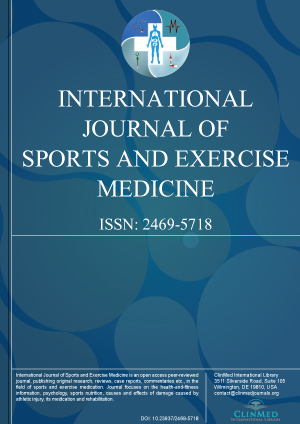Open Access DOI:10.23937/2469-5718/1510121
Determining Rheumatology Patient Interest in a Group Strength Training Program - Results of an Exercise Survey
Kevin Rhie, MD, Danielle M Feger, MS, Rayford R June, MD, Christopher N Sciamanna, MD, MPH and Sharon E Banks, DO, MS
Article Type: Research Article | First Published: February 20, 2019
Exercise has proven benefits in rheumatologic disease including reducing inflammation and improving symptoms. A Group Strength Training (GST) program design has improved adherence to exercise in primary care patients but the effect is unknown in rheumatology patients. We examined the interest of rheumatology patients with different diagnoses and the effect of comorbidities in pursuing an organized GST program. We conducted a cross-sectional survey of patients from a rheumatology practice in cent...
Open Access DOI:10.23937/2469-5718/1510120
Shoulder Infrared Thermography in Chronic Rotator Cuff Tears - Temperature Assessment and Variation in Affected and Non-Affected Shoulders
Bernardo Nunes, MD, Jorge Lopes, MD, Miguel Relvas-Silva, MD, Hélio Alves, MD, Ricardo Vardasca, PhD and Manuel Gutierres, PhD
Article Type: RESEARCH ARTICLE | First Published: February 13, 2019
The obtained results demonstrated IRT as highly reproducible. A small decrease in skin temperature after exercise has been related to peripheral vasoconstriction, and this was confirmed in both affected and non-affected shoulders. Nevertheless, it was expected on affected shoulders a lower baseline and after exercise skin temperatures, which was not confirmed, as no significant difference was found between groups. As such, the role of IRT as complimentary mean of diagnosis is yet to be establish...
Open Access DOI:10.23937/2469-5718/1510119
Effect of Eight Weeks of Exercise Training on Lipid Profile and Insulin Sensitivity in Obese Person
NGAYIMBESHA Adrien, BIZIMANA Jean Berchmans and GAKIMA Marie Stella
Article Type: Research Article | First Published: February 11, 2019
Obesity is a metabolic abnormality characterized by increased levels of plasma free fatty acids and triglycerides, decreased levels of High-Density Lipoprotein (HDL), and abnormal Low-Density Lipoprotein (LDL) composition. The most significant contributing factor for obesity-related dyslipidemia is likely uncontrolled fatty acid release from adipose tissue, especially visceral adipose tissue, through lipolysis, which causes increased delivery of fatty acids to the liver and synthesis of Very-Low...
Open Access DOI:10.23937/2469-5718/1510118
Learning from Pokemon GO and Preparing for Potter: The Impact of Augmented Reality Video Games on Adolescent Physical Activity
Laura McLaughlin BA, Prithwijit Das MSEd, Kate Fruitman BA and Ruth Milanaik DO
Article Type: Research Article | First Published: February 11, 2019
Only 25% of US high school students meet CDC physical activity guidelines. Over 40% report playing video games for > 3 hours/day. This epidemic of inactivity may lead to health consequences including obesity. Augmented Reality Games (ARGs) may increase activity through video gameplay. Our objective was to quantify the effect of an ARG, Pokemon GO, on adolescent physical activity. Pokemon GO led to a minimal but significant initial increase in activity. Although future studies are needed to deter...
Open Access DOI:10.23937/2469-5718/1510117
Accelerated Junctional Rhythm in Athlete's Heart: An Unusual Presentation
Lahut D, Bodur B and Tosun O
Article Type: Case Report | First Published: February 11, 2019
The athlete's heart refers to a heart which has gained physiological adaptation mechanisms due to long term training in various sport activities. Sinus bradycardia, sinus arrhythmia, first degree atrioventricular block and second degree mobitz type I AV blocks are most common electrocardiographic findings in athlete's heart. In our case we observed first degree atrioventricular block with pathological PR interval values second degree mobitz type I (Wenckebach) atrioventricular block and accelera...

